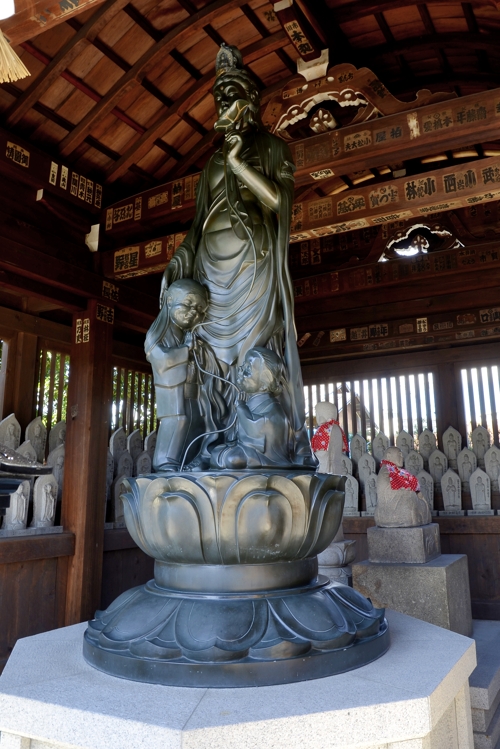August 22nd and undaunted by the previous day's trials, I rolled out to make my way from Kyoto down south to Wakayama, stopping at two Osaka-area temples along the way. There were two in particular that were reported to be very convenient to get to by public transportation (and from non-JR stations, thus I could use the heck out of my Kansai Thru-Pass), so I planned my route around them.
First stop, Soji-ji, Temple 22 of the Pilgrimage and the one from which the walking trail still leads to Katsuo-ji (visited the day before). Soji-ji is the size of an unassuming city temple.
There were some old ladies chatting in the shade of the garden near the pond, and I could feel them watching me.
 |
| I was proud that I was able to read the sign. It said you were permitted to ring the bell, but to please do so gently, as it's really freakin' old. I did. |
Not all temples offer prayers, services, or amulets for pets, but Soji-ji does. It's principal image is a thousand-armed eleven-faced Kannon riding on the back of a turtle. The legend about this is that a nobleman was going about his daily business and saw some kids tormenting a turtle. He made them stop, and released the turtle into the sea. Later on, Kannon sent the same turtle saved this nobleman's son from drowning.
 |
| So I took a photo of a poster. |
This turtle tale, combined with the story of the sandalwood of which the Kannon image is carved (said to have been dedicated to Kannon, ordered for the carving of the statue, then lost into the water along the way, but it washed up again in Japan), gave me the impression that this temple has something to do with being in the right place at the right time. The message is that things go where they are supposed to be.
Since it also had to do with pets, I had been looking forward to getting a couple of charms for the family's dogs along the way.
 |
| Buddhist Pet Cemetery. |
Soji-ji is also famous for a dedication of knives that takes place on April 18th of each year. There is a fish-slicing ceremony related perhaps to a tradition that . There's also a statue of the Bokefuji Kannon we saw at
temple fifteen. I said a prayer but didn't take a photo of her.
Stop two was Fujii-dera, in the town of the same name, another city temple (as opposed to sprawling mountain complex) filled with the wisteria (fuji) plants that would make it absolutely gorgeous (and crowded, I'm sure) come early May. Fujii-dera is temple number 5 of the 33, and was the first for me of that opening sequence of temples that wraps around the peninsula of Wakayama Prefecture.
It was a nice little oasis of space, mostly empty when I was there at the end of the afternoon, with gates on all sides leading into the city's streets.
 |
| Can you imagine this fuji in May? |
The Kannon image at Fujii-dera (I didn't happen to pass a poster with the image printed) is another thousand-armed Kannon, but this one actually has a
thousand arms. Most of the representations of senju-Kannon have a good many arms, but most of them don't actually bear the full thousand.
 |
| A few blossoms persist through the August heat! |
The image is put on display on the 18th of each month, and on August 9th for sen-nichi mairi, which conveys the benefits in one day of prayer that you would expect of a thousand (normal) days of prayer.
 |
| I love the fabric in this portrayal of the wind. |
Fujii-dera was beautiful, but I didn't have a lot of time there, as it was getting on toward closing time. What made it peaceful also made it kind of lonely. Plus I'd seen a lot of temples in a few days, two per day for as long as I could walk it.
I was headed for Wakayama City and the end of my Pilgrim Trail....











No comments:
Post a Comment